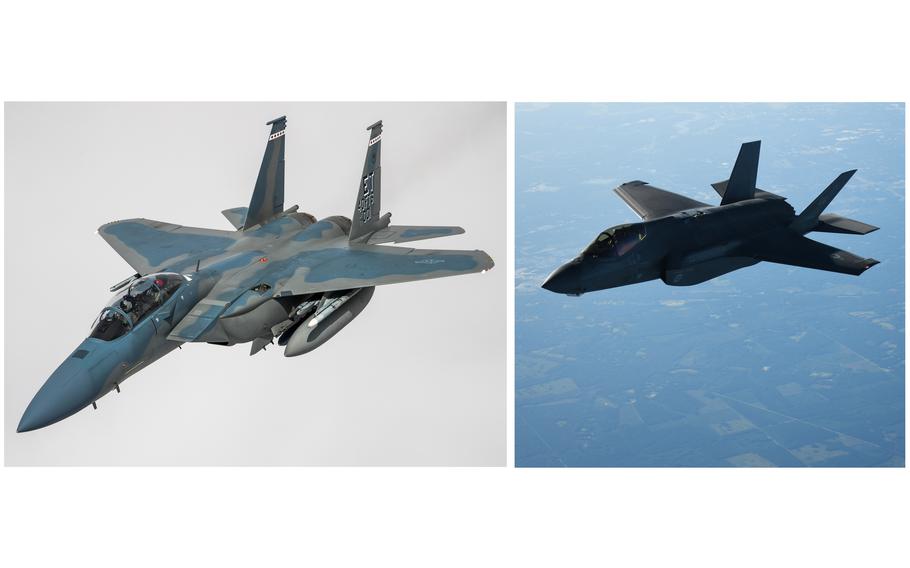
An F-15EX Eagle II, left, from the 40th Flight Test Squadron, 96th Test Wing out of Eglin Air Force Base, Fla., flies over Northern California in May 2021. An Air Force F-35A Lightning II assigned to the 33rd Fighter Wing from Eglin Air Force Base flies over Savannah, Ga., in September 2020. (U.S. Air Force photos)
As American politicians have repeatedly haggled over federal budgets in recent years, often delaying critical funds for the military to start new weapons programs, the Chinese have built larger, more capable forces with an eye on challenging U.S. power, Air Force Secretary Frank Kendall warned senators on Tuesday.
“Time is my greatest concern,” Kendall told the Senate’s defense appropriations subpanel. “We are in a race for military technological superiority with a capable pacing challenge [in China]. Our cushion is gone. We are out of time.”
The top civilian official for the Air Force and Space Force placed much of the blame on Congress, saying repeated stopgap funding measures in lieu of full yearly budgets in recent years have slowed his services’ progression in new technology aimed at countering the growing capabilities of the Chinese in air and space warfare, including in anti-satellite technologies and hypersonic weapons.
Kendall said the $217.5 billion fiscal 2025 budget request for the Department of the Air Force was hamstrung by an agreement forged last year under the 2023 Fiscal Responsibility Act, which capped the Defense Department budget for 2025 at $849.5 billion, a roughly 1% cut to the department’s 2024 spending plan when adjusted for inflation.

Air Force Secretary Frank Kendall testifies in Congress in September. (Carlos Bongioanni/Stars and Stripes)
The budget caps forced the Air Force to make “difficult choices” to slow the acquisition of major weapons — including the F-35A Lightning II stealth fighter jet and the F-15EX Eagle II fighter jet — to invest in developing the next generation of combat aircraft, including unmanned and autonomous fighters, said Gen. David Allvin, the service chief of staff.
Under the budget proposal, the Air Force’s aircraft fleet would drop from almost 5,200 to about 4,900, the smallest inventory the service has seen in decades. Allvin defended the proposal as necessary under the budget constraints and because the Air Force is retiring older aircraft that it believes would be troubled in a near-peer conflict with an enemy capable of shooting down its planes.
“We’ve made tradeoffs to keep the Air Force’s operational readiness today at the minimal acceptable to meet the nation’s demands while seeking to preserve the previous year’s advances in modernization,” the general told lawmakers.
Meanwhile, the Chinese have boosted defense spending by at least 7% each year in recent years, Kendall and other defense official have said. China already boasts the world’s largest navy and could soon surpass the U.S. with the largest air force, Pentagon officials have projected.
Several of the subcommittee’s senators said Tuesday that they shared Kendall’s frustrations with the slow budget approval processes in recent years. The Pentagon has operated about five of the last 15 years under continuing resolutions — the stopgap funding procedures that force the Pentagon to operate at the previous year’s spending levels and halt work on new weapons programs and construction. The Defense Department operated roughly the first six months of fiscal 2024 under continuing resolutions.
Sen. Jon Tester, D-Mont., blasted the use of continuing resolutions to fund the government, noting the Senate’s defense appropriations subcommittee had approved a defense appropriation for fiscal 2024 in July.
Tester also criticized the framework of the Fiscal Responsibility Act — forged by President Joe Biden and then-House Speaker Kevin McCarthy, R-Calif. — as “totally inadequate” for defending the United States.
“I think we’ve got to figure out a way to make sure in this dangerous time, which I believe is the most dangerous time in the world since the early 1960s, that we give you the money you need,” the senator told Kendall. “It [the Defense Department budget] is just inadequate … because there was a decision made to put a 1% cap down months ago. That was a bad decision.”
Kendall told the subcommittee that his military services were able to win any conflict if called upon today, but China is rapidly closing the capability gap. He said he was made aware earlier Tuesday morning of new, classified data that “was concerning.”
“The threat keeps changing. It keeps getting worse,” he said. “I think we’re at a situation where in the near term, the immediate term, we are at an acceptable level of risk. … [But] the risk is increasing over time, and if we focus on the risk today at the expense of that higher levels of risk that we’re going see China as continues to modernize, [then] we’re going to have to be in a very intractable position within just a few years.”
For the first time in modern history, Kendall said, the United States was facing a competitor in China with military “purchasing power” that exceeds America’s.
“China is actively developing and expanding capabilities to challenge strategic stability, attack our critical space systems, and defeat our ability to project power — especially airpower,” he said. “Conflict is not inevitable. But it could happen at any time.”